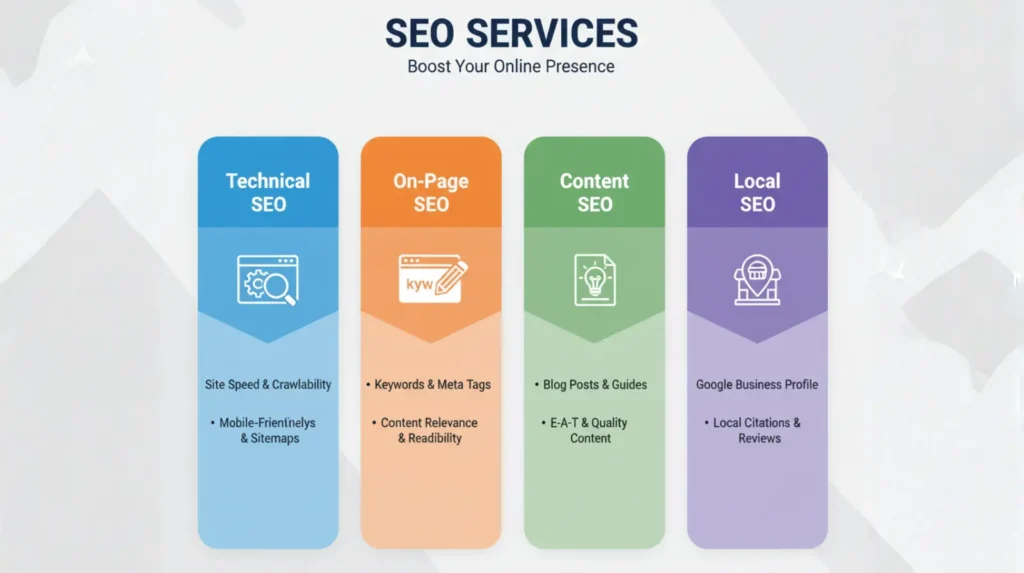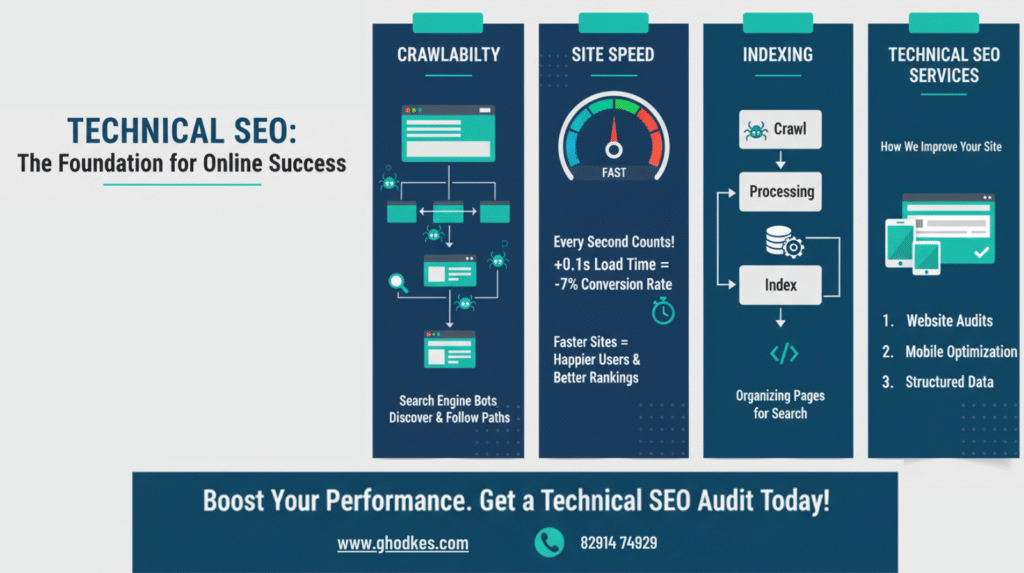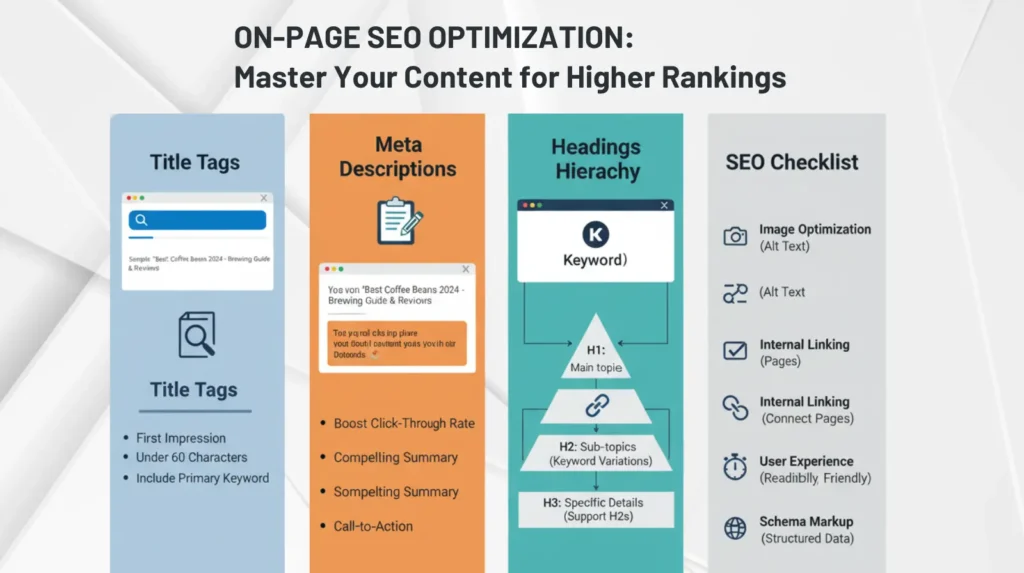If you’ve ever tried to answer the deceptively simple question what do SEO services include? you know there’s more to it than a handful of keywords and a few blog posts. Search visibility today is the result of dozens of moving parts working together: a fast, crawlable site; useful, original content; a clean information architecture; strong local and brand signals; and disciplined measurement. The good news: when you understand the scope, you can build the right plan, hire with confidence, and hold partners accountable to outcomes.
This guide is a practitioner’s blueprint. It explains, in plain language, what do SEO services include across strategy, technical improvements, on‑page work, content production, local optimization, digital PR, analytics, and ongoing governance. You’ll also find pricing models, evaluation questions for vendors, a 90‑day roadmap, and KPIs to keep everyone honest.
What you’ll learn:
- A concise summary of what do SEO services include from discovery to outcomes
- The technical and content work that actually moves rankings and revenue
- How local, international, and e‑commerce SEO differ from generic playbooks
- Pricing structures, red flags, and how to scope a Statement of Work that delivers
- A realistic 90‑day plan to go from “audit” to “live results” with minimal thrash
Let’s turn search from a black box into a repeatable operating system for growth.

What Do SEO Services Include? A One‑Page Summary
At a high level, here’s what a complete engagement covers:
- Discovery and strategy: goals, baselines, data setup, topical authority plan
- Technical SEO: crawlability, indexation, site architecture, performance, structured data, rendering, internationalization
- On‑page optimization: keyword‑to‑intent mapping, internal linking, schema, accessibility, UX tweaks that influence engagement
- Content strategy and production: pillars and clusters, briefs, editorial, updates to aging assets, visual support and media optimization
- Local SEO: Google Business Profile, citations, reviews, location pages, service area optimization
- Digital PR and link earning: campaigns that earn relevant coverage and references
- Analytics and reporting: Search Console and analytics setup, dashboards, testing, and variance explanation
- Governance: change control, QA and pre‑flight, release notes, and stakeholder updates
If you’re asking what do SEO services include at a tactical level, the sections below break each area into specific deliverables you can expect.
Strategy That Connects SEO to Revenue
Before changing a single title tag, a solid firm will align search work to business outcomes.
Discovery and baseline
- Stakeholder interviews: product, marketing, sales, and support
- KPI selection: conversions, revenue, qualified leads, calls, or bookings
- Baselines: organic traffic by page group and intent, revenue attribution, current rankings and SERP features
- Data quality check: correct tracking, clean UTM usage, Search Console property verification
Audience and intent mapping
- Customer jobs‑to‑be‑done and pain points
- Query intent segmentation: informational, commercial, transactional, navigational
- Topic cluster planning: hubs (pillars) and supporting pages (clusters) to build authority
Roadmap and forecast
- 90‑day plan with weekly sprints
- Forecast ranges (conservative, base, optimistic) tied to planned activities
- RACI (who owns what) and clear exit criteria for each phase
When a prospect asks what do SEO services include on day one, the answer should be: a plan that ties efforts to the metrics your leadership cares about.
Technical SEO: Make the Site Easy to Discover, Render, and Trust
Technical health is the foundation. If crawlers can’t reach, understand, or render pages, content won’t help.

Crawlability and indexation
- robots.txt and crawl directives: allow important sections; block only what must be private
- Canonicals: self‑referencing on canonical pages; avoid conflicting signals (canonicals vs. robots vs. hreflang)
- XML sitemaps: only indexable URLs, kept fresh, split by type and size
- Pagination and faceted navigation: no infinite parameter traps; canonicalization or meta‑robots for non‑canonical filters
Site architecture and internal linking
- Logical hierarchy: home → category → subcategory → detail
- Shallow depth for key pages; breadcrumbs and contextual links
- Hub‑and‑spoke clusters to reinforce topical relationships
Performance and page experience
Core Web Vitals (field data priority)
- LCP: optimize hero images, server response, and render‑blocking resources
- INP: break up long tasks, minimize heavy scripts, prioritize interactivity
- CLS: reserve space for media, preload fonts, avoid late‑loading banners
- Mobile responsiveness and accessibility (contrast, focus states, alt text)
Rendering and JavaScript
- Ensure critical content and links are available without user interaction
- Server‑side rendering or hydration patterns tested for parity between source and rendered DOM
Structured data and entities
- JSON‑LD for Article, Product, FAQ, HowTo, Organization, BreadcrumbList, and relevant types
- Validation with Rich Results Test and monitoring for warnings/errors
Security and trust
- HTTPS across the site, correct canonical protocol
- No mixed content; safe form handling; clear privacy policies
If you’re still wondering what do SEO services include technically, the shortest answer is: make every important page fast, crawlable, indexable, and machine‑readable.
On‑Page Optimization: Align Pages With Searcher Intent
On‑page work connects user needs, content, and site structure.

Keyword‑to‑intent mapping
- Each page targets a primary intent and 2–4 closely related sub‑topics
- Titles and H1s use natural language that reflects intent, not awkward keyword stuffing
Content quality and formatting
- Clear structure: H2s and H3s that mirror search questions; table of contents for long pages
- Scannability: short paragraphs, pull‑quotes, bullets, visuals
- Answer boxes: concise answers (40–60 words) and lists/tables for snippet opportunities
Internal linking and anchor strategy
- Contextual links from related pages; descriptive anchor text that signals the destination’s topic
- Link hubs (pillars) to clusters and vice versa; add breadcrumbs with schema
Media and accessibility
- Original images, diagrams, and embedded media with descriptive alt text
- Captions and transcripts for video; compression and modern formats (WebP/AVIF)
On‑page trust signals
- Author bylines with credentials, last‑updated dates, and references to reputable sources
- Transparent contact details and policies where relevant
In everyday terms, when someone asks what do SEO services include on‑page, it’s: create the best answer on the web to a searcher’s problem, and format it so people and search engines can understand it quickly.
Content Strategy and Production: Build Topical Authority
Content without a plan becomes expensive noise. A strong program sets a cadence and builds authority around clear themes.
Topical mapping and editorial planning
- Select 3–5 core themes aligned to business goals
- For each theme, publish one pillar (comprehensive overview) and 6–12 clusters (deep dives)
- Include buyers’ guide content for commercial intent and how‑to content for informational needs
Briefs and subject‑matter input
- Detailed briefs with H2/H3 structure, questions to answer, required visuals, and expert sources
- Interviews or collaboration with internal experts and customers for first‑hand insights
Publishing cadence and updates
- Realistic schedule (e.g., 2 clusters/week + 1 pillar/month)
- Quarterly content updates: refresh stats, examples, and screenshots; consolidate overlaps
Formats that perform
- Long‑form guides with diagrams and checklists
- Comparison and alternative pages for commercial queries
- Case studies with numbers and process detail
- Tools, calculators, and templates for utility
A well‑run editorial team can answer “what do SEO services include for content?” in one sentence: a plan to publish fewer, better pieces that build authority, earn links, and convert.
Local SEO: Be Chosen in “Near Me” Moments
For brands with physical locations or service areas, local visibility is a growth engine.
Google Business Profile (GBP)
- Complete, accurate profiles: primary/secondary categories, attributes, services
- Photos and videos that reflect reality; brand‑consistent cover image
- Posts for updates, offers, and events; Q&A management
Citations and consistency
- NAP (name, address, phone) consistent across major directories and niche listings
- Ongoing cleanup to remove duplicates and incorrect data
Reviews and responses
- Review generation tied to real purchase or service moments
- Empathetic, prompt responses; escalate issues offline when needed
- Showcase selected reviews on location pages with schema
Location pages
- Unique content per location: staff introductions, services, service areas, parking, busy hours
- Embedded maps, click‑to‑call, and localized FAQs; LocalBusiness schema
If a local owner asks what do SEO services include for their store, the answer is: accurate profiles, strong location pages, real reviews, and consistent data that make you the obvious choice.
Digital PR and Link Earning: Authority With Integrity
Not all links are created equal. Quality beats quantity, and relevance beats raw metrics.
Campaign types that work
- Data stories: proprietary research or thoughtful analysis of public data
- Expert commentary: fast, quotable insights on timely topics
- Interactive tools or calculators: useful assets others want to reference
- Case‑driven narratives: “how we did X” with numbers and steps
Prospecting and outreach
- Build lists by topical relevance and author focus; personalize pitches
- Respectfully follow up once; provide assets (charts, quotes, methodology)
Measurement and quality control
- Track referring domains, traffic from coverage, and assisted conversions
- Inspect link context: surrounding text, placement, and site quality
- Avoid gimmicks: paid links, private blog networks, and irrelevant link swaps
When someone wonders what do SEO services include off‑site, the answer should never be “buy links.” It should be: initiatives that earn attention and coverage because they’re useful.
Analytics, Reporting, and Testing: Make Better Decisions, Faster
If you can’t measure it, you can’t improve it.
Clean setup
- Search Console: verified properties (domain‑level preferred), sitemap submission, and coverage monitoring
- Web analytics: conversions and revenue tracking by channel; events for scroll, form submissions, and key interactions
- Looker Studio or BI: unified dashboards by topic and intent
KPIs that matter
- Visibility: impressions and ranking distribution for target topics and SERP features
- Engagement: clicks, CTR, sessions, time on page, scroll depth
- Outcomes: conversions and revenue from organic by page group
- Technical health: Core Web Vitals pass rates, index coverage, crawl anomalies
Testing and iteration
- Title and meta experiments (safe templates, not whiplash on every page)
- Internal link placement tests and anchor clarity
- Content refresh impact comparisons
When a finance leader asks what do SEO services include in reporting, you should be able to show: what moved, why, and what you’re doing about it next.
E‑commerce SEO: Category and Product Pages That Convert
Stores face specific challenges that generic advice misses.
Category and facet strategy
- Canonicalization and indexation rules for filters; avoid duplicate near‑identical pages
- Collection copy that adds value; answer common questions and link to top sub‑collections
Product detail pages (PDPs)
- Unique titles, bullets, and descriptions; original images and videos; comparison tables
- Reviews, FAQs, and UGC integration with schema; back‑in‑stock alerts
- Structured data: Product, Offer, AggregateRating, Review, and FAQPage where appropriate
Pagination and crawl budget
Avoid deep pagination waste; highlight best‑sellers and add links to top categories
Feeds and discovery
Clean product feeds for shopping surfaces; accurate availability and price
For a merchant asking what do SEO services include for a catalog, this is the short list: clean collections, enriched PDPs, and filter rules that prevent crawl chaos.
International SEO: Right Page, Right Market
Going global requires more than translation.
Strategy and structure
- Choose structure: ccTLDs, subdomains, or subfolders; align with resources and authority
- Market research: local demand, competitors, and cultural nuances
Hreflang and localization
- Correct hreflang implementation (language‑region pairs), including x‑default where relevant
- Professional translation and localization of examples, currency, and units
Duplicate control and governance
- Prevent cross‑market cannibalization; ensure canonical self‑references per locale
- Consistent brand terms; local spelling variants documented
If leadership asks what do SEO services include for expansion, the honest answer is: careful planning, correct hreflang, and true localization that respects the audience.
Website Redesigns and Migrations: Protect What You’ve Earned
This is where many programs lose years of progress unless you have a plan.
Pre‑launch
- URL mapping: one‑to‑one redirects for every legacy URL; test coverage
- Content parity: ensure critical content, titles, headers, and schema survive
- Technical parity: robots, canonicals, sitemaps, hreflang, Core Web Vitals, analytics tags
- Staging crawl and rendered content comparison
Launch
- Remove noindex/disallow used in staging; push redirects; submit new sitemaps
- Live crawl; monitor logs and Search Console coverage; fix high‑priority 404s
Post‑launch
- Closely track rankings and clicks for top pages; compare engagement metrics
- Triage regressions; escalate fixes with dev/design
If you’re wondering what do SEO services include during a redesign, it’s this: a migration runbook with owners and time‑boxed fixes that protect revenue.
Pricing Models and How to Scope Work That Delivers
Common models
- Monthly retainer: ongoing strategy, content, technical, and reporting; predictable and collaborative
- Project‑based: audits, migrations, or discrete campaigns; clear scope and timeline
- Hybrid: retainer with defined quarterly projects; flexible yet accountable
What good scopes include
- Objectives tied to business outcomes
- Deliverables by month or sprint (audits, briefs, pages, fixes)
- Access requirements (CMS, analytics, Search Console, code repos)
- Stakeholder availability and approval SLAs
- Clear success metrics and reporting cadence
Red flags
- Guaranteed rankings (no one controls the algorithm)
- Vague link packages or “DR promises”
- Heavy focus on vanity metrics without business tie‑back
When procurement asks what do SEO services include in a contract, the answer should be: specific deliverables, data access, and shared accountability for outcomes.
Vendor Evaluation: Questions to Ask Before You Sign
- Can you walk us through a recent program: goals, constraints, and measured outcomes?
- What do SEO services include in your first 90 days with us? What will we see and when?
- How do you prioritize work across technical, content, and off‑site within our budget?
- Who will be on our account weekly, and what’s their experience in our industry?
- How do you measure quality beyond rankings (e.g., E‑E‑A‑T, engagement, conversions)?
- How do you manage migrations or large releases to avoid traffic loss?
- What happens if we disagree on priorities? How do you resolve disputes with data?
A trustworthy partner can answer each clearly and show artifacts (dashboards, briefs, runbooks) without hand‑waving.
A 90‑Day Roadmap You Can Trust
Days 1–30: Foundation
- Discovery, baselines, and KPI alignment
- Technical crawl and “fix fast” items (indexation leaks, critical CWV issues)
- Topical map for two core themes; 6–10 content briefs
- Build dashboards; verify tracking and Search Console; set weekly cadence
Days 31–60: Execution
- Publish 4–6 cluster articles and one pillar; add schema and internal links
- Resolve top technical items by template; monitor field data improvements
- Launch one digital PR effort (data story or expert commentary)
- Optimize underperforming titles/meta; test one internal linking change
Days 61–90: Scale and refine
- Publish additional clusters; refresh one legacy asset with promise
- Address remaining technical priorities; clean sitemaps and parameters
- Expand PR; pitch 10–20 targeted outlets; track coverage and link quality
- Review KPIs; document what worked; plan next quarter’s scope
When stakeholders ask what do SEO services include in the first quarter, you can point to this plan with named owners and dates.
KPIs and Dashboards: Keep Everyone Honest
Leading indicators
- Impressions by topic; ranking distribution (Top 3/10/50)
- Core Web Vitals pass rates; index coverage; crawl anomalies
- Publishing velocity: briefs → drafts → live pages
Lagging indicators
- Clicks, sessions, CTR by page group and intent
- Conversions and revenue from organic
- Assisted conversions and multi‑touch attribution
Quality and E‑E‑A‑T signals
- Author pages published; citations added; last‑updated cadence
- Reviews and brand mentions; coverage and link quality trends
Tie one decision per week to what the dashboard shows: optimize a title, add internal links, freshen a page, or push a technical fix.
Common Pitfalls (and How to Avoid Them)
- Publishing for volume, not value
- Fix: Every brief must answer “What’s new here?” with a proof requirement (example, data, screenshot)
- Ignoring consolidation
- Fix: Merge overlapping content; 301 to the best version; update internal links
- Technical debt that never shrinks
- Fix: Triage by template and business impact; time‑box fixes; document change logs
- Over‑indexing on content scores
- Fix: Use scores for coverage hints; win with originality and UX
- One‑and‑done audits
- Fix: Treat the backlog like product work; run sprints and show outcomes
- Vanity reporting
- Fix: Focus on organic revenue and qualified leads; explain variance with cause, not just numbers
When a skeptical exec asks what do SEO services include beyond “blogs,” show them the operating system you run weekly.
Conclusion: Turn SEO Into a Weekly Habit That Compounds
The right answer to “what do SEO services include?” isn’t a checklist it’s a system. You need strategy tied to outcomes, fast technical fixes, helpful content that earns attention, local accuracy, disciplined PR, and dashboards that drive decisions. When those pieces run in a weekly rhythm, growth compounds: more qualified visitors, healthier conversion, and durable visibility that outlasts trend‑chasing.
Your next steps:
- Write down your top two objectives for search over the next 90 days
- Audit tracking, Search Console, and Core Web Vitals; fix high‑impact issues first
- Choose two topical hubs and publish four helpful pieces with schema and internal links
- Optimize your Google Business Profile and location/service pages if relevant
- Build a simple scorecard; tie one decision every week to what it shows
Do this for one quarter, and the question “what do SEO services include?” becomes your team’s routine clear priorities, steady shipping, and results you can bring to the next leadership meeting with confidence.
FAQs: Straight Answers to Common Questions
What do SEO services include for a small business?
A lean program covers a technical clean‑up, Google Business Profile optimization, a simple topical hub with 6–8 helpful articles, location or service pages, review generation, and a dashboard that shows calls, forms, and visits from search.
What do SEO services include for an e‑commerce site?
Clean category and filter rules, enriched product pages with reviews and FAQs, structured data at scale, a prioritized Core Web Vitals plan, a smart internal linking pattern, and content that answers buying questions for important collections.
What do SEO services include for content creation?
A topical map, detailed briefs with expert inputs, editing for clarity and accuracy, original visuals, schema, internal links, and a refresh schedule. Quality beats quantity, always.
How long before we see results?
Technical and CTR fixes can show movement within weeks. Content hubs and authority building typically compound over 2–3 months, with larger gains over quarters.
Do we need ongoing work or just an audit?
Audits identify issues. Progress comes from fixing, publishing, and iterating. Most businesses benefit from a quarterly cadence: ship improvements, review KPIs, and plan the next set.
How do we measure success credibly?
Track conversions and revenue from organic, not just rankings. Segment by topic and intent. Explain variance with cause (e.g., new pages, technical fixes, seasonality).
What do SEO services include that help with brand trust?
Author credentials, accurate citations, transparent policies, real reviews, and content that demonstrates first‑hand experience. These align with search guidelines and user expectations.








